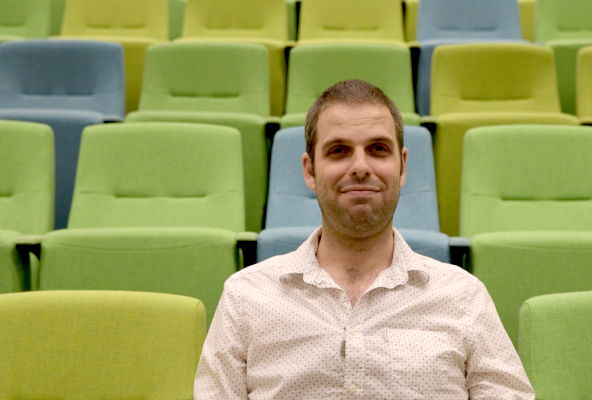Podcast: The most aggressive cancer in the brain

Glioblastoma is the most aggressive cancer originating in the brain, and it affects people of all ages. Dr Jens Bunt, a scientist in the Brain Disorders and Development lab at QBI, is researching to find a cure. In this episode, he explains what brain cancer is and how tumours occur.
Transcript
[MUSIC]
Donna Lu
Hi, I’m Donna Lu.
Jess McGaw
And I’m Jess McGaw.
Donna Lu
And you’re listening to A Grey Matter, the Queensland Brain Institute’s neuroscience podcast.
Jess McGaw
Today we’re talking about brain cancer with Dr Jens Bunt.
Dr Jens Bunt
Hello, my name is Jens Bunt, I’m from the Netherlands, and I’m a research fellow in the laboratory for brain development and disease at the Queensland Brain Institute.
Donna Lu
And what is your specific research area?
Dr Jens Bunt
I’m researching how genes that regulate proliferation and differentiation during development are involved in diseases such as brain cancer.
Donna Lu
For those who aren’t familiar with scientific terms, what is proliferation and differentiation?
Dr Jens Bunt
You can see it as that each cell is like a child in the beginning, it has no job, it can become everything; but at a certain stage after it has developed and it has had its allocation, it becomes specialised in a certain job, like, scientist, or hairdresser, or surgeon. You can imagine that once you have a certain job, it is really hard to start doing another job. So during development, you first have a lot of cells that can become everything – in our case, the brain, so it can be neurones, or glia, or blood vessel cells. But later on, once they become these cells, they can’t get another job, basically stuck in the job for the rest of their lives.
Donna Lu
That’s an excellent analogy.
Jess McGaw
So exactly what is glioblastoma? Is it a cancer, a tumour, and how does that manifest in the brain?
Dr Jens Bunt
Well, it’s always quite hard to understand all the terminology. So, when we’re talking about a tumour, that includes all the cancers – tumours are masses of cells that shouldn’t be there, and they can be aggressive, and then we call it a cancer, or they can be just like a mole, not really causing any problems. So in the brain there’s about fifty different types which are currently being characterised by pathologists, and they are classified also by how aggressive they are, so how fast they grow, how much they can invade, how much they can test the size. Glial blastoma is the most aggressive of a sub-group called glioma, and they’re called glioma because they originated from cells that are called glia. People might not know, but most of the brain doesn’t exist our of neurons, but out of glia, and they do actually everything you can imagine to help the neurones. They provide all the nutrients, they help with isolating their signals so they can conduct better, they form the immune system for the brain, and these cells are not surprisingly the most common source of brain tumours. So about half to a third of all brain tumours that exist arise from the glial cells. Glioblastoma is the most aggressive one, and at the moment, after about fifteen months after diagnosis, half of the patients died in the five years.
Donna Lu
And so the other really terrible thing about glioblastoma is that it tends to affects people who are quite young, or relatively young. Is that correct?
Dr Jens Bunt
Well, glioblastoma has an age range from basically zero to one hundred, but yes, there are some distributions there. So, certain sub-types of brain tumours have a higher incidence at certain ages, so we have for instance medulloblastoma, which is found more in children, and glioblastoma is the most common cause of death due to a brain tumour in adults.
Jess McGaw
How do you identify if someone has glioblastoma, and what are the signs and symptoms?
Dr Jens Bunts
First of all, I’m not a clinician, so I can’t give you a definite answer, but the problem with brain tumours is that they’re in the brain, in contrast to, for instance, breast tumours, where on the outside you can sometimes see it, but you can also see it. For brain tumours, it’s much harder, and sometimes there is not a direct correlation between the size or the aggressiveness of the precise brain tumour, but it has more to do with the symptoms of which area of the brain it arises, and most of the symptoms are due to the tumour pressing on other regions. So you can imagine when you are working in a room and suddenly it gets overcrowded, it’s really hard to do your job, so some people have the kind of symptom like feeling dizzy, nauseous, they might have some problems with moving their hand or with seeing. Some of the problems [?] are really vague and not always straight away indicative, and so most of the time the … patient presents to surgeon or doctor only after they do the surgery, they can be determined what type of tumour it is. And that’s also why, if you watch those medical television programs, is that they always send straight away a piece to pathology, because for managing and treating it it’s very important to know and make decision about the risk – do I want to try and cut more away with the risk that they might damage some of the brain. So those are the things that they mainly want to know which you can’t see from the outside.
Presented by Donna Lu and Jessica McGaw. Produced and edited by Jessica McGaw.
A Grey Matter is the Queensland Brain Institute's podcast about neuroscience. It features music from Incompetech, available under a Creative Commons Attribution-Noncommercial license.
Music used:
‘There It Is’ by Kevin McLeod – bit.ly/1nW96tY


